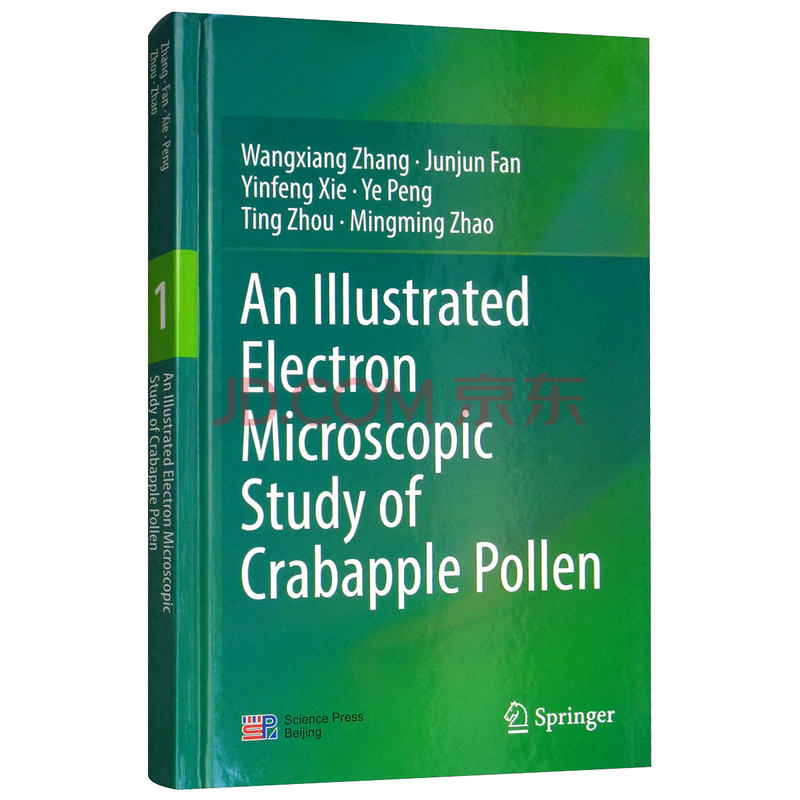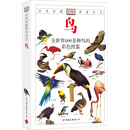内容简介
This book focuses on the morphology, the exine omamentation, and the associated evolutionary trends of crabapple pollen and anatomical developmental patterns. To examine the genetic evolutionary patterns of crabapple pollen traits, we constructed an interval distribution function based on characteristic pollen parameters and used a binary trivariate data matrix (Xi Yi Zi) to reflect the exine omamentation regularity of the pollen. Our findings should inform the taxonomic status of the Malus sp.Pollen electron micrographs from a total of 26 species and 81 cultivars of Malus were recorded in this book. All 107 figures and 642 scanned pollen images constitute primary data obtained by the authors. The images in this book are clear, threedimensional, and aesthetically pleasing. They are accompanied with text descriptions and provided a method for the indication of the different types of information that can be expected.This book can provide a reference for researchers, especially plant breeders. These people need to know the pollen structure and their compatibility for further breeding. In doing so, it has much better opportunity to produce new taxa. The research methods in palynology are also a great reference for other plant taxa.
目录
1 Pollen Morphological Characteristics of Ornamental Crabapples
1.1 Significance of the Study of Crabapple Pollen Morphology
1.2 Observation Methods for Crabapple Pollen Phenotypes
1.3 Pollen Morphological Characteristics of Ornamental Crabapples
1.4 Analysis of Pollen Morphology Traits of Crabapple
1.4.1 Stability of Pollen Phenotypic Traits
1.4.2 Analysis of Intrapopulation Variability of Phenotypic Traits in Crabapple Pollen
1.5 Chapter Summary
2 Evolutionary Law for Ornamental Crabapple Pollen Traits
2.1 Evolutionary Research Background on Plant Pollen Traits
2.2 Study Methods for Investigating the Evolution of the Phenotypic Traits of Crabapple Pollen
2.2.1 Analysis of the Evolutionm'y Relationship of Pollen Between Species from the Malus
2.2.2 Analysis Methods for Assessing the Trend of Evolution Between Cultivars and Species
2.3 Evolutionary Relationships of Crabapple Pollen Phenotypic Traits
2.3.1 The Evolutionary Relationships of the Pollen Phenotype
Traits of Malus Species Based on Classical Taxonomy
and Molecular Evolutionary Trees
2.3.2 Evolutionary Trends of Pollen Phenotypic Traits
of Natural Species and Cultivars of Crabapples
Based on Boxplot Analysis
2.3.3 Evolutionary Trends of the Pollen Phenotypic
Traits of Natural Species and Cultivars of Crabapples
Based on Frequency Distribution Characteristics
2.4 Chapter Summary
3 Evolutionary of Pollen Ornamentation in Ornamental Crabapples
3.1 Research Background on Plant Pollen Ornamentation Evolution
3.2 Quantitative Analysis Methods for the Evolution of Crabapple Pollen Ornamentation
3.3 Evolutionary Trend of Pollen Ornamentation in Ornamental Crabapples
3.3.1 Distribution Characteristics of the Ornamentation Patterns of Crabapple Germplasm Pollen
3.3.2 Pollen Ornamentation Evolution in the Populations of Species and Cultivars
3.3.3 Evolution of Pollen Ornamentation Patterns in Parental and Progeny Populations
3.4 Chapter Summary
4 Ultrastrueture Observation of M. halliana Pollen During Development
4.1 Research Background of M. halliana Pollen Development
4.2 Mixed Bud Morphological and Developmental Observation in M. halliana
4.3 Ultrastructural Observations of M. halliana Pollen Development
4.3.1 Initial Differentiation Stage of the Anthers
4.3.2 Sporogenesis
4.3.3 Formation of Microsporocytes
4.3.4 Meiosis
4.3.5 Mononucleated Microspore Stage..
4.3.6 Pollen Maturation Stage
4.4 Ultrastructural Observations of Anther Wall Formation in M. halliana
4.4.1 Sporogenesis
4.4.2 Microsporocyte Formation Stage
4.4.3 Meiosis
4.4.4 Pollen Maturation Stage
4.5 Anatomical Causes of Pollen Abortion in Monopetalous M. halliana
4.6 Chapter Summary
5 Electron Microscopic of Crabapple Pollen
5.1 M. angustifolia
5.2 M. baccata
5.3 M. domestica vat, binzi
5.4 M. floribunda
5.5 M. fusca
5.6 M. honanensis
5.7 M. ioensis
5.8 M. mandshurica
5.9 M. micromalus
5.10 M. niedzwetzloe'ana
5.11 M. ombrophila
5.12 M. platycarpa
5.13 M. prunifolia
5.14 M. pumila
5.15 M. robusta
5.16 M. rockii
5.17 M. sieversii
5.18 M. spectabilis
5.19 M. sylvestris
5.20 M. toringoides
5.2 l M, tschonoskii
5.22 M. turkmenorum
5.23 M, yunnanensis
5.24 M, 'Abundance'
5.25 M, 'Adams'
5.26 M. 'Almey'
5.27 M, 'Ballet'
5.28 M, 'Brandywine'
5.29 M. 'Butterball'
5.30 M. 'Cardinal'
5.31 M. 'Centurion'
5.32 M. 'Cinderella'
5.33 M. 'Cloudsea'
5.34 M. 'Coralburst'
5.35 M, 'Darwin'
5.36 M. 'David'
5.37 M. 'Dolgo'
5.38 M. 'Donald Wyman'
5.39 M. 'Eleyi'
5.40 M. 'Everest'
5.41 M. 'Fairytail Gold'
5.42 M. 'Firebird'
5.43 M. 'Flame'
5.44 M. 'Furong'
5.45 M. 'Golden Hornet'
5.46
前言/序言
The book An Illustrated Electron Microscopic Study of Crabapple Pollen contains both beautiful images and in-depth descriptions. It not only has strong theoretical concepts but also records the electron micrographs of the pollen of 107 crabapple germplasms (including 26 species and 81 cultivars). The electron micrographs are high quality and multi-dimensional, showing a large amount of information. This provides unique ideas, methods, and theoretical insights for the classification and genetic evolution of crabapple germplasm resources and also has important refer-ence value for other similar studies.
Being the advisor of Wangxiang Zhang for his master's and doctoral studies, I am not only his teacher but also his friend. As early as in the 1990s, I established the Ginkgo Research Group at Nanjing Forestry University. Wangxiang Zhang,as a major member of the group, independently organized and participated in the nationwide collection and evaluation of ginkgo germplasm resources. He went to China's main distribution and cultivation areas of ginkgo, deep into the moun-tains and countryside. He had to overcome many difficulties, and more than 700 ginkgo germplasm resources were collected. He completed the preparation work for establishing the Ginkgo Germplasm Gene Bank of China Forestry Adminis-tration and Jiangsu Province, laying the foundation for the preservation and innovation of ginkgo germplasms. This experience directly resulted in and inspired new ideas for the innovation and industrial development of crabapple germplasms. For a long time, Wangxiang Zhang has been interested in the research and development idea of industry chain linkages; he has held a long-term and pragmatic scientific research attitude and is diligent in both writing and field research work, opening a window for a crabapple dream for the four wonderful seasons.
Since 2003, Wangxiang Zhang and others have systematically carried out research on the collection and evaluation of crabapple germplasm resources as well as the innovation and industrialization development technology of germplasms. A science and technology innovation team of ornamental crabapple was gradually established, and a series of scientific research results have been achieved. After 14 years, more than 200 crabapple germplasm resources have been collected and preserved, and the Crabapple Germplasm Resource Bank of Nanjing Forestry University was established. In 2016, this gene bank was ranked by the Forestry Administration of China as a national-level gene bank for crabapple germplasms, and this gene bank provides a high-level technology platform for the innovation of crabapple germplasms. Through regional intro-duction and cultivation testing and evaluation, more than 80 excellent ornamen-tal cultivars were selected, and 13 of them received approval or certification from the High-Quality Forest and Wood Species Approval Committee of Jiangsu Province. A key technical system of crabapple breeding was established.Through the hybrid combination breeding of 96 crosses in 6 batches, more than 300 excellent single plants of ornamental crabapples with multi-target traits were obtained, and applications for approval were submitted for 14 new cultivars of crabapples, providing a large number of candidates for the continuous inno-vation of new cultivars.
Wangxiang Zhang and his colleagues took advantage of the resource platform of the National Crabapple Germplasm Gene Bank. They creatively constructed a distribution function of the phenotypic traits of crabapple pollen as well as a binary three-dimensional data matrix model reflecting the overall omamentation regularity of pollen, revealing the evolution of the pollen of crabapple germplasms. They proposed for the first time that all natural species of crabapples have high ornamen-tation regularities, but germplasm with high regularity is not necessarily a natural
species. This research c






















